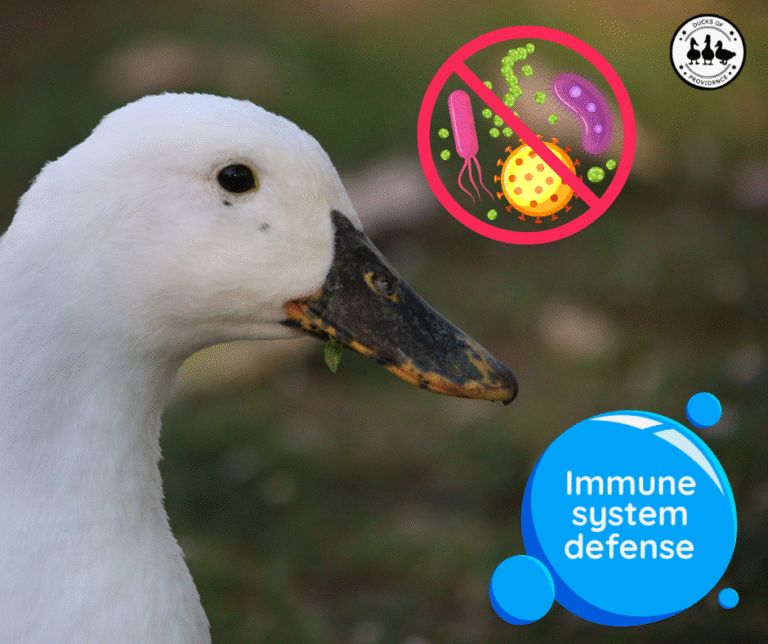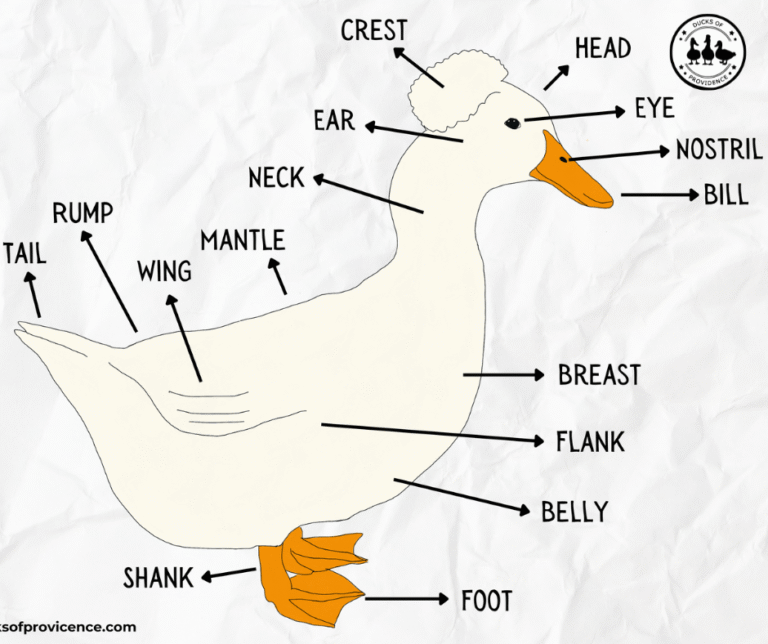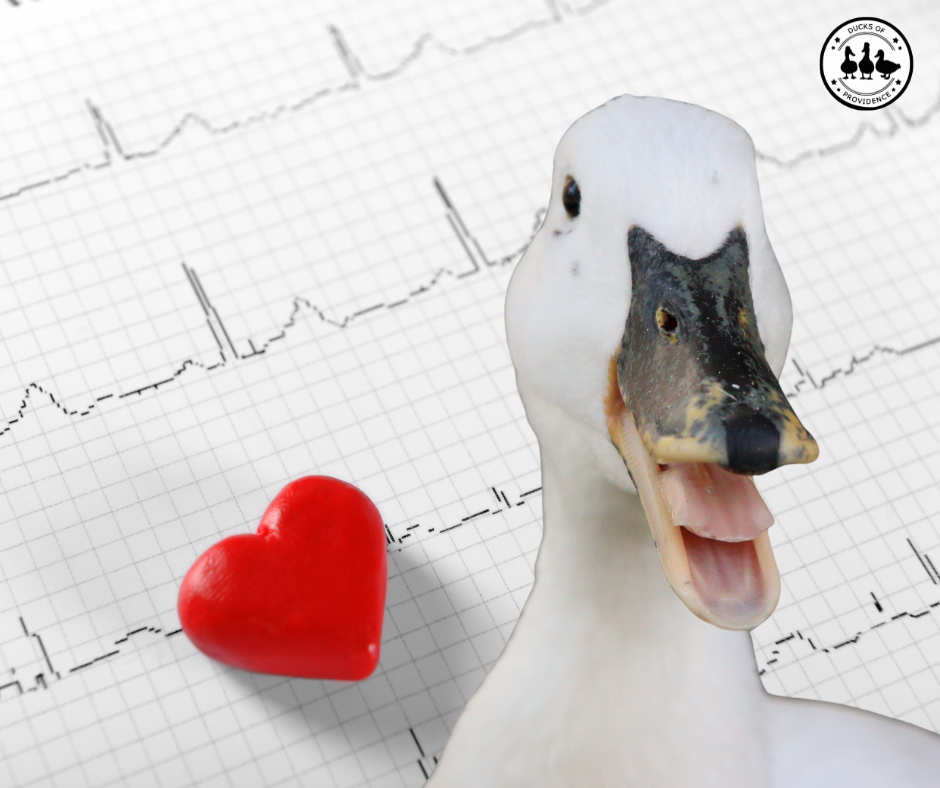
Duck Diagnostic Chart: Vital Signs, Tests, and What Your Duck’s Poop Is Telling You
When it comes to caring for pet ducks, knowledge is one of the most powerful tools we have. Ducks are masters at hiding illness, so by the time they show visible signs, their condition may already be serious. That’s why it’s essential for every duck parent to understand the basics of duck health—including what’s normal, what’s not, and when to call the vet.
In this post, we’ve compiled a comprehensive Duck Diagnostic Chart to help you monitor your duck’s well-being at home and better understand what your vet might look for during an exam. From normal heart rates and temperature ranges to common blood tests and poop analysis, this guide is designed to empower you with the information you need to catch problems early and advocate for your duck’s care.
Whether you’re a new duck parent or have years of experience like us, this resource is one we wish we had from the beginning—clear, science-based, and made with love for the ducks who depend on us.
Ducks of Providence is free, thanks to reader support! Ads and affiliate links help us cover costs—if you shop through our links, we may earn a small commission at no extra cost to you. Thanks for helping keep our content free and our ducks happy! 🦆 Learn more
Vital Signs Checklist for Ducks 🩺
While ducks can’t tell us when something feels off, their bodies often give us subtle clues—if we know what to look for. Checking your duck’s vital signs regularly, especially if they seem a little off, can help you catch potential problems early. It’s also helpful to know these values so you can speak the same language as your vet during a health check or emergency visit.
Below is a quick-reference chart of typical vital signs for adult ducks. Keep in mind that values can vary slightly by breed, age, and individual health, but these ranges are a solid starting point for home monitoring.
| Parameter | Normal Range | Notes |
|---|---|---|
| Heart Rate | 130–230 bpm (beats per minute) | Measured with a stethoscope or Doppler; faster in ducklings |
| Respiratory Rate | 13–40 breaths per minute | Look for chest movement or slight beak gaping |
| Body Temperature | 102°F–106°F (38.9°C–41.1°C) | Cloacal temperature using a digital thermometer |
| Weight | Varies by breed | Track over time—sudden loss is a red flag |
| Cloacal Tone | Should be firm and close well | Weak or prolapsed tissue may indicate health issues |
| Hydration Check | Skin turgor and moist mouth | Pinch skin on neck—should snap back quickly |
Heart Rate in Ducks: What’s Normal and Why It’s So Fast
A healthy adult duck typically has a resting heart rate between 130 and 230 beats per minute (bpm), depending on the specific breed of duck. During periods of inactivity or darkness, the heart rate may be lower, while it increases during active periods or in response to light. That may sound alarmingly fast—especially when you compare it to humans, who average around 60 to 100 bpm, or even dogs (70–120 bpm) and cats (120–140 bpm).
So, why is a duck’s heart racing even when it’s at rest? The answer lies in their anatomy and metabolism.
Birds, including ducks, have high metabolic demands. Their bodies are designed for constant movement, from dabbling and foraging to flying in some species. To support this, ducks have a larger heart relative to body size than mammals do. This powerful heart pumps oxygen-rich blood quickly and efficiently to fuel their active muscles and regulate their high body temperature (which typically ranges from 104°F to 107°F).
Another key anatomical factor is their four-chambered heart, just like mammals, which keeps oxygenated and deoxygenated blood completely separate. This allows for more efficient circulation and helps maintain their fast metabolism.
💡 Fun fact: A duck’s heart beats so fast, especially when stressed or handled, that it’s best measured using a stethoscope or Doppler device—counting manually is nearly impossible!
Respiratory Rate: How Fast Should a Duck Breathe?
A healthy adult duck breathes about 13 to 40 times per minute when at rest. This can vary slightly based on the specific breed, age, and activity level of the duck. For example, resting ducks may have a slower rate, while flying ducks can have a significantly higher rate. That’s a bit higher than a human’s resting respiratory rate (12 to 20 breaths per minute) but fairly comparable to cats and dogs, which average 20 to 30 breaths per minute.
Just like with heart rate, a duck’s respiratory rate is closely tied to its high metabolism. Ducks need more oxygen to support their energy demands—whether they’re foraging, swimming, or keeping warm in colder weather. Their respiratory system is designed to handle this need efficiently, and it works quite differently from our own.
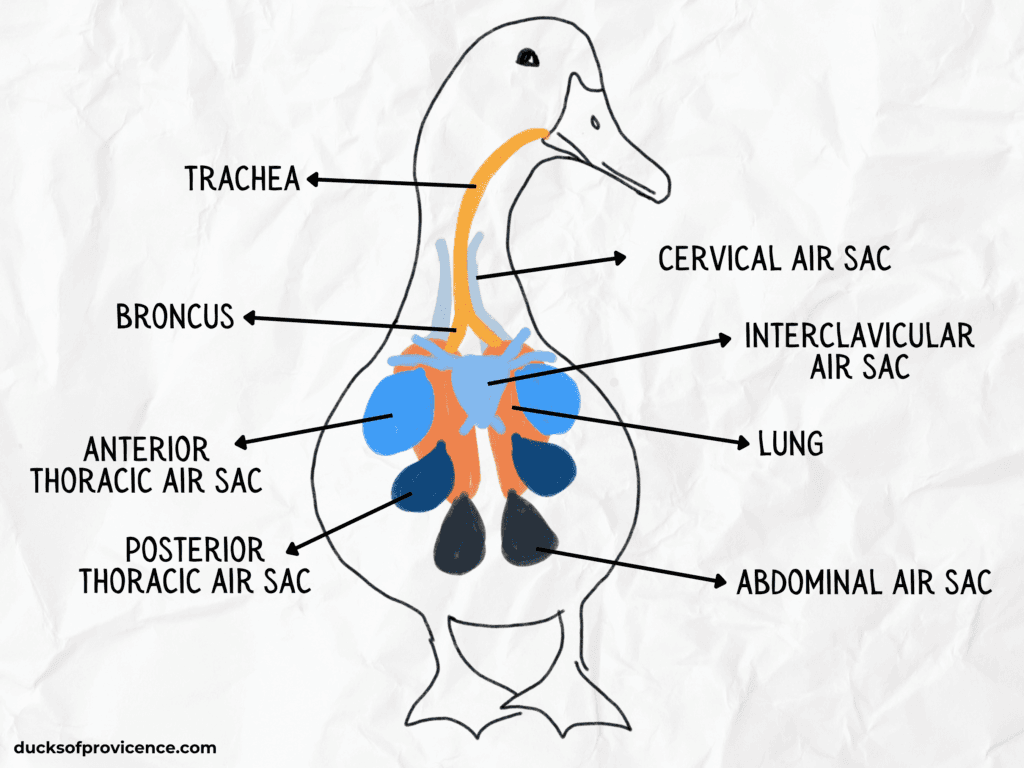
Ducks have a unique respiratory anatomy that includes not just lungs, but also a system of air sacs throughout their body. These air sacs act like bellows, allowing for continuous airflow through the lungs in one direction. This system is far more efficient than the tidal breathing we humans use, where air moves in and out of the same passageway.
Because of this specialized setup, ducks can extract more oxygen per breath than mammals—but they also need to breathe faster to maintain that oxygen flow, especially under stress or heat.
💡 What to watch for: Breathing that is heavy, labored, rapid (even at rest), open-mouthed, or comes with wheezing or clicking sounds can all be signs of respiratory distress or infection and should prompt a vet visit.
Body Temperature: Ducks Run Hot—And Here’s Why
A healthy adult duck has a core body temperature of around 102°F to 106°F (38.9°C to 41.1°C). That’s significantly warmer than humans, who typically sit at 98.6°F, and even warmer than cats and dogs, whose normal temps range from 100°F to 102.5°F.
This higher body temperature isn’t a fluke—it’s a reflection of their avian metabolism and evolutionary adaptations. Ducks, like all birds, are endothermic (warm-blooded) and have a very high metabolic rate. Their bodies are constantly producing heat to support energy-demanding processes like feather maintenance, egg-laying, and in some cases, flight.
One reason ducks can maintain this elevated temperature is their efficient circulatory system and their insulating feathers, which trap warm air close to their skin. However, their temperature can still fluctuate slightly depending on environmental factors. That’s why it’s best to check body temperature at rest, ideally in a calm, indoor setting.
To measure a duck’s body temperature, use a lubricated digital thermometer placed gently in the cloaca. It only takes a few seconds, and having a helper to keep your duck calm can make the process much easier.
💡 Why it matters: A low body temperature in a duck (under 103°F) may signal shock, infection, or exposure to cold. A spike above 108°F could indicate heat stress or systemic illness and needs urgent attention.
Weight: One of the Most Telling Signs of Health
Unlike some other vital signs, weight is something every duck parent can and should track at home—and it can reveal a lot about your duck’s health, often before other symptoms show up.
There’s no single “normal” weight for all ducks because it varies by breed, age, sex, and whether your duck is a pet or bred for production. For example, a small Call duck might weigh just over a pound, while a Pekin can reach 8–11 pounds, and a Muscovy drake even more. That’s why it’s more useful to track trends over time for your individual duck, rather than comparing to a general standard.
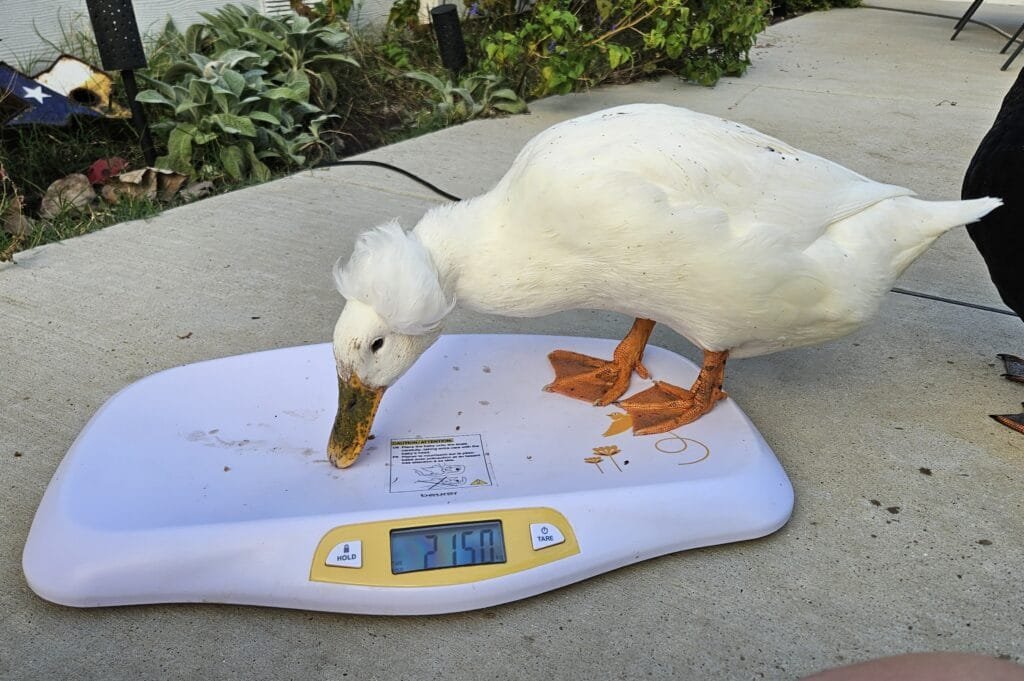
💡 Tip: Weigh your duck once a month using a baby scale. Always weigh them at the same time of day, preferably before feeding.
Even a loss of 5–10% body weight can be a red flag—especially if it’s sudden or unexplained. It may indicate issues like parasites, internal illness, reproductive problems, or nutritional imbalance. On the other hand, steady weight gain outside of natural growth or pre-lay weight can also be a concern, particularly in heavier breeds prone to joint or liver problems.
Personal note: I keep a little notebook where I jot down each duck’s weight monthly. It only takes a minute, but it’s helped me catch problems early more than once. It’s also incredibly helpful to bring this information to your vet if your duck does become ill.
Cloacal Tone: A Subtle But Telling Sign
The cloaca is the single external opening that ducks use for passing waste, laying eggs, and mating. It’s a crucial part of a duck’s anatomy—and checking its condition can tell you a lot about their reproductive and digestive health.
In a healthy duck, the cloacal tissue should be firm, elastic, and well-toned, meaning it closes completely and bounces back when gently touched. This tight closure helps prevent infections and keeps internal tissue where it belongs.
Loss of cloacal tone can be a sign of serious issues, including:
- Prolapse (when tissue protrudes from the vent)
- Chronic egg-laying stress
- Reproductive disease or infection
- Neurological problems or general weakness
How to check: When handling your duck (especially during a health check or bath), gently inspect the vent area. Look for signs of swelling, discoloration, discharge, or open/loose tissue that doesn’t retract properly. Healthy tissue should be pink, moist, and snug.
What your vet might do: If cloacal tone is poor, your vet may perform a digital exam, look for signs of prolapse or egg binding, and sometimes prescribe anti-inflammatories, calcium, or hormone therapy (like deslorelin or leuprolide) to reduce reproductive stress.
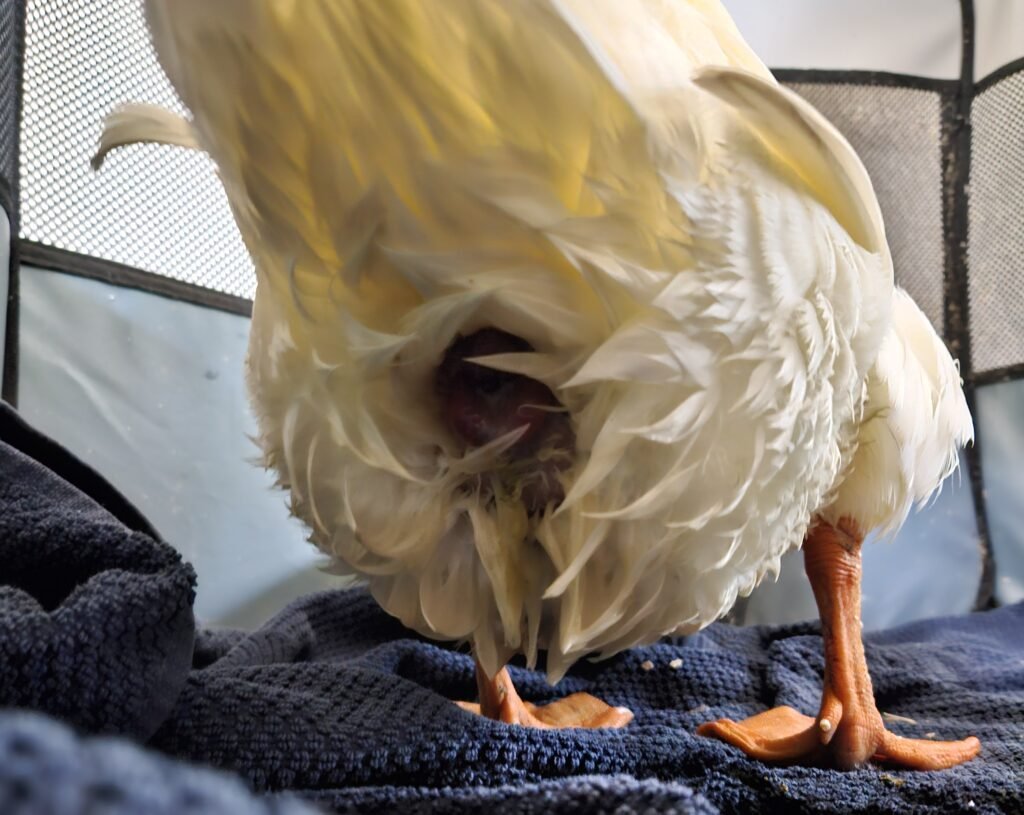
Keeping an eye on this area is especially important for laying hens, older ducks, or any duck recovering from reproductive issues—like our Emma, who healed from a prolapse with the help of a suture and lots of TLC.
Hydration Check: A Quick Way to Gauge Overall Health
Ducks get a lot of their hydration through both drinking water and wet food, and they’re usually excellent at regulating their own intake—unless something is wrong. Dehydration can set in quickly, especially in hot weather, during illness, or if a duck is too weak or stressed to access water.
Luckily, you can do a simple hydration check at home in just a few seconds.
Two Easy Ways to Check Hydration:
- Skin Turgor Test: Gently pinch the skin on the side of the neck or under the wing. In a well-hydrated duck, the skin should snap back immediately. If it stays tented or returns slowly, this may indicate dehydration.
- Mouth and Eyes: Check for moist, shiny mucous membranes in the mouth. The eyes should look bright and alert—not sunken or dry.
Additional signs of dehydration:
- Lethargy or weakness
- Dry, crusty vent
- Thick, sticky saliva or difficulty swallowing
- Reduced poop output or unusually dry droppings
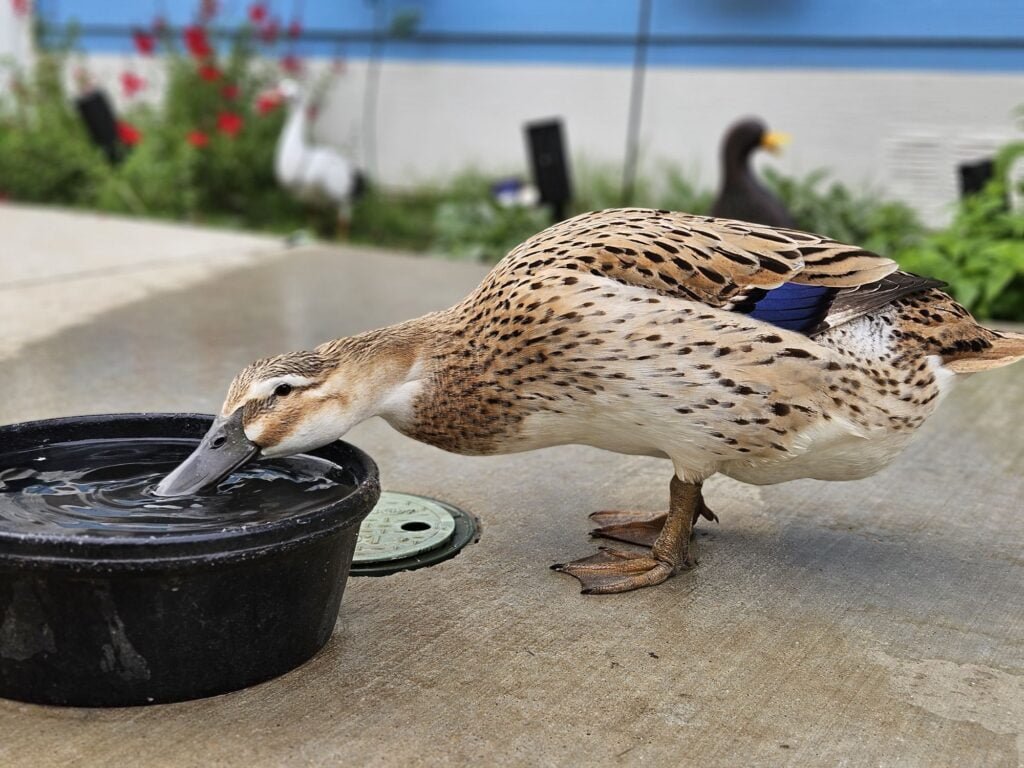
What your vet might do: In cases of dehydration, a vet may administer subcutaneous fluids (under the skin) and address any underlying cause, such as infection, heat exhaustion, or digestive upset.
Duck parent tip: If your duck isn’t drinking, try offering water mixed with electrolytes, small amounts of unsweetened fruit juice, or adding peas or wet food to encourage interest. In hot weather, ensure water is always clean, cool, and easily accessible.
Common Veterinary Tests for Ducks 🧪
When your duck isn’t feeling well—or even just acting a little “off”—a vet visit can offer vital answers. But for many duck parents, the tests vets run can seem unfamiliar or even intimidating. What exactly are they checking for? What do those blood panels, X-rays, and fecal tests actually tell us?
In this section, we’ll walk you through the most common veterinary diagnostics for ducks, what each one checks, and why it matters. Whether your duck is dealing with a reproductive issue, possible metal poisoning, or just a mystery illness, these tools help your avian vet get a clearer picture of what’s going on inside—so they can offer the best possible care.
| Test | What It Checks | Why It’s Important |
|---|---|---|
| Complete Blood Count (CBC) | Red/white blood cells, infection, anemia | Evaluates immune response or chronic illness |
| Blood Chemistry Panel | Liver/kidney function, electrolytes, glucose | Key for systemic illness, metal toxicity, egg binding |
| Fecal Flotation/Gram Stain | Parasites and bacteria | Often used for diarrhea or digestive issues |
| X-rays (Radiographs) | Bones, egg binding, internal metal | Helps detect fractures, reproductive issues, or ingestion |
| Ultrasound | Reproductive organs, fluid, masses | Often used for laying problems or abdominal swelling |
| Cloacal or Crop Swab | Yeast, bacteria, parasites | Used with symptoms like vent irritation or sour crop |
| Heavy Metal Screening | Zinc, lead levels | Important for unexplained lethargy or neurological symptoms |
Complete Blood Count (CBC)
A CBC is one of the most common and informative lab tests your vet may run. It looks at the number and condition of red blood cells, white blood cells, and platelets in your duck’s bloodstream.
- Red blood cells help carry oxygen. Low levels may indicate anemia, blood loss, or nutritional deficiencies.
- White blood cells reflect immune activity. Elevated counts can point to infection, inflammation, or even stress.
- Abnormal values can also signal chronic illness, especially when combined with other test results.
💡 This test is often done if your duck seems weak, lethargic, or has unexplained weight loss.
Blood Chemistry Panel
This test looks deeper into organ function and metabolic health, measuring values like liver enzymes, kidney markers, glucose, calcium, and electrolytes.
It’s especially useful for:
- Diagnosing egg binding or reproductive disorders
- Monitoring for dehydration or electrolyte imbalances
- Detecting signs of metal toxicity (like zinc or lead exposure)
- Evaluating chronic conditions that may not show obvious symptoms
We’ve used this test multiple times with our own ducks—especially when Krümel had elevated zinc levels and reproductive concerns.
Fecal Flotation and Gram Stain
These are simple but powerful tools to check your duck’s poop for parasites, yeast, and harmful bacteria.
- Fecal flotation is used to identify internal parasites like worms or protozoa.
- Gram stain shows whether bacterial populations are normal or imbalanced, and can detect overgrowths that may cause diarrhea or weight loss.
💡 This test is often used if your duck has loose droppings, loss of appetite, or a swollen belly.
X-rays (Radiographs)
X-rays give your vet a visual look inside your duck’s body, especially useful for bones, reproductive organs, and the digestive tract.
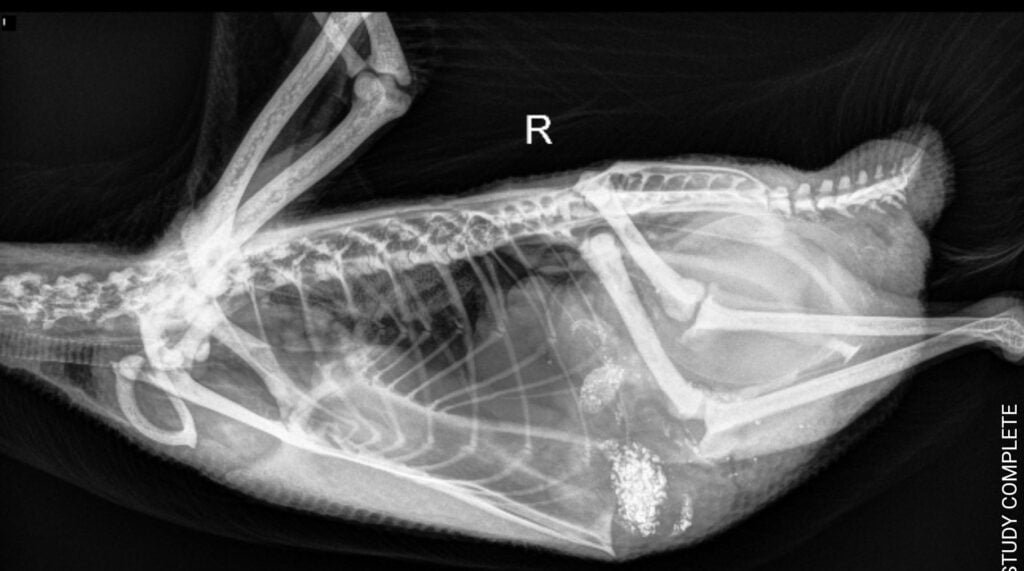
Common reasons for X-rays:
- Suspected egg binding
- Prolapsed tissue
- Lameness or fractures
- Metal ingestion, such as screws or coins
💡 While metal sometimes doesn’t show up clearly (especially if small), X-rays can still guide decisions on treatment or surgery.
Ultrasound
Ultrasound uses sound waves to image soft tissues and is especially helpful for diagnosing reproductive issues.
Vets may use it to:
- Look for retained eggs or follicular cysts
- Detect fluid buildup or tumors
- Monitor the ovaries or uterus
💡 If your duck has a swollen belly or lays irregular eggs, an ultrasound may be part of her workup.
Cloacal or Crop Swab
These swabs collect samples from your duck’s vent or crop and are analyzed under a microscope or sent for culture.
Used to detect:
- Yeast infections (like sour crop)
- Bacterial infections
- Parasites or abnormal organisms
💡 Especially important if your duck has a foul-smelling crop, vent discharge, or trouble swallowing.
Heavy Metal Screening
This specialized test measures zinc, lead, and other toxic metals in the blood. Even small amounts of these can make ducks very sick.
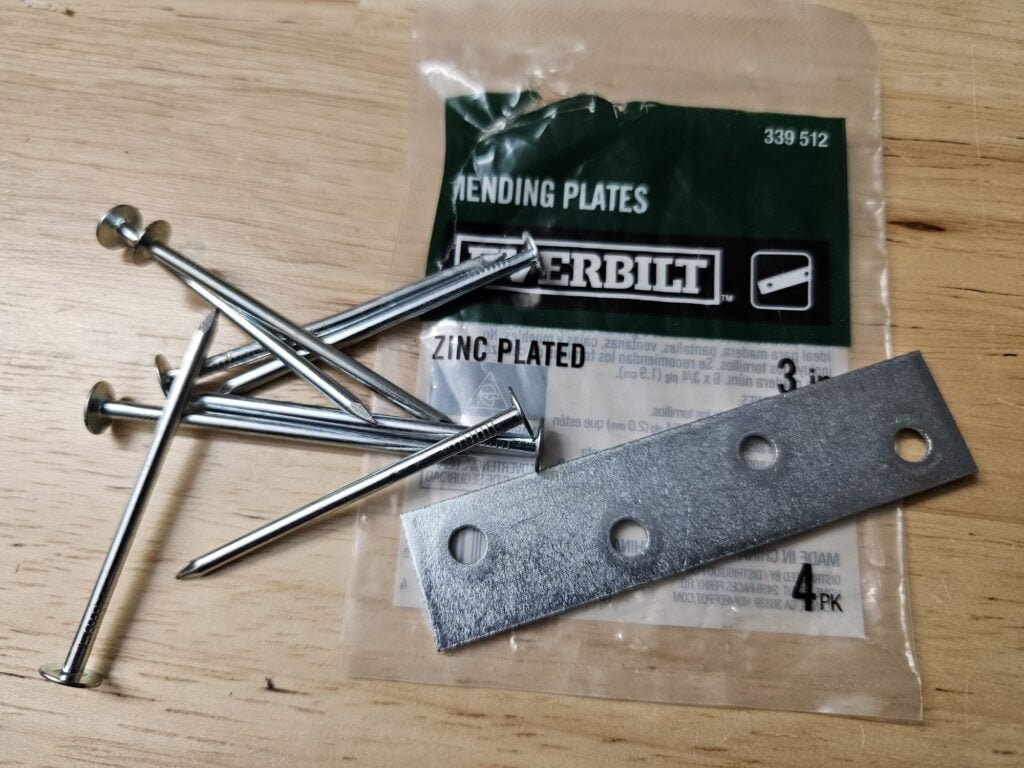
Symptoms of metal toxicity include:
- Lethargy or weakness
- Neurological signs like tremors or loss of balance
- Digestive upset
- Reproductive failure
💛 We had to run this test for Krümel, whose high zinc levels caused serious illness. Early detection helped us start chelation therapy in time.
Duck Poop: What’s Normal and What’s Not 💩
Monitoring your duck’s droppings might not be glamorous, but it’s one of the most effective ways to catch early signs of illness. Duck poop varies a lot depending on diet, hydration, stress, and health status, so learning what’s normal for your duck can help you spot problems before they escalate.
Below is a guide to both healthy droppings and warning signs, including the diseases or conditions that might be associated with each.
What Healthy Duck Poop Looks Like
| Type | Description | Meaning |
|---|---|---|
| Typical Dropping | Firm or slightly soft, with brown or green feces and white urates (the chalky part) | A sign of good digestion and hydration |
| Caecal Poop | Soft, pasty, very dark brown to black, with a strong smell | Totally normal! Ducks pass this 1–2 times a day to empty their cecum |
| Green Poop from Veggies | Bright pine green, often looser after eating greens like lettuce or kale | Harmless and food-related |
| Blue or Purple Poop | Often follows blueberries, red cabbage, or beets | Diet-related and not concerning |
| Pea Poop | Light green, often softer after eating lots of peas | Normal if it returns to usual color later |
Abnormal Duck Droppings
| Type | Appearance | Possible Cause | Notes |
|---|---|---|---|
| Watery or Foamy | Very loose or bubbly | Diarrhea from bacterial/viral infection, stress, parasites | Persistent diarrhea requires vet attention |
| Bright Green (neon) | Vivid green, not from diet | Hardware disease, lead/zinc poisoning | Red flag for metal toxicity—urgent vet care needed |
| Greenish-Yellow | Mucousy, dull green-yellow | Duck Virus Enteritis (DVE) | Often paired with lethargy or sudden death in flocks |
| Yellow/Mustard Droppings | Mucus-like or thick yellow | Peritonitis, egg yolk coelomitis | May also be seen with belly swelling or labored breathing |
| Black Tar-Like | Shiny black, sticky | Renal failure, internal bleeding | May signal advanced kidney disease or hemorrhage |
| Bloody Diarrhea | Bright red streaks or blood-tinged mucus | Capillary worms, coccidiosis, Duck Virus Enteritis | Emergency—bring a fecal sample to your vet |
Tips for Duck Parents
When it comes to monitoring your duck’s health, poop can be one of the most telling indicators—but it’s also one of the most misunderstood. Ducks naturally produce a wide variety of droppings throughout the day, and once you get familiar with your flock’s normal patterns, it becomes easier to spot when something’s off.
One of the best things you can do is simply pay attention. Get to know the typical color, consistency, and smell of your duck’s droppings during normal, healthy times. That way, you’ll be the first to notice if anything changes. For example, if your duck suddenly starts passing watery, discolored, or foul-smelling poop, it could be the first sign of an infection, digestive upset, or more serious illness.
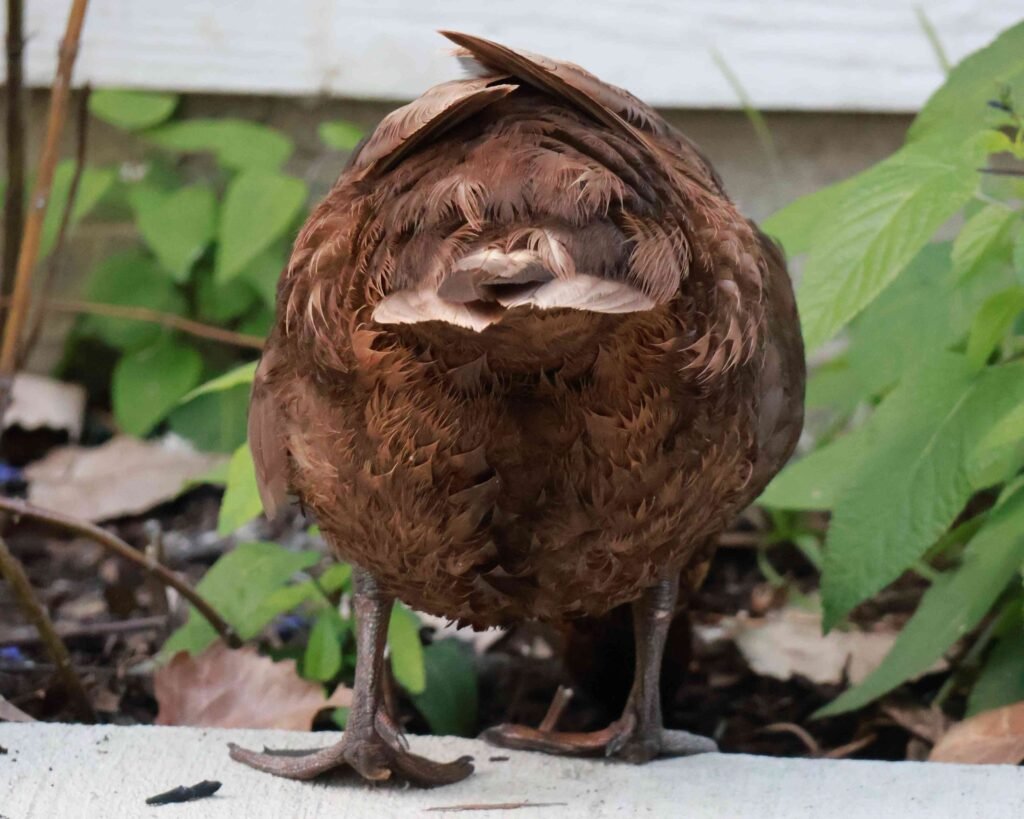
It’s also important to consider context. A single strange-looking poop after a new treat like peas, blueberries, or kale might not mean anything is wrong. But if the unusual droppings persist, especially alongside symptoms like loss of appetite, lethargy, excessive drinking, or abnormal posture, it’s time to dig deeper.
When in doubt, trust your instincts. If something doesn’t seem right, it probably isn’t. Take clear photos of the droppings and consider bringing a fresh sample to your avian vet. Many intestinal parasites, bacteria, or signs of internal issues can only be diagnosed under the microscope or with lab work.
Most of all, remember that you don’t need to be an expert to spot problems early—you just need to be observant and proactive. Your ducks rely on you to notice when they’re not quite themselves, and by learning to read the signs (yes, even in poop), you’re giving them the best chance at a long, healthy life.
Home Health Monitoring Tips
Caring for ducks means paying attention not just to their routines, but to the little changes that might signal something deeper going on. Ducks are prey animals by nature, and they’re surprisingly good at hiding signs of illness. That’s why regular home health monitoring is so important—and why small, simple checks can make a big difference.
One of the best habits you can build is to keep a weekly weight log for each duck. Use a baby scale and weigh them at the same time of day, preferably before meals. Even a small, unexplained drop in weight can be an early red flag for digestive issues, parasites, or reproductive problems. If you track it regularly, you’ll notice patterns and catch changes much sooner than by eye alone.
Also make it part of your routine to observe your ducks’ appetite, activity level, posture, and grooming behavior. A duck that suddenly stops eating, isolates herself from the flock, walks with a hunched back, or stops preening is almost always dealing with discomfort. These subtle shifts are often the first clues that something isn’t right.
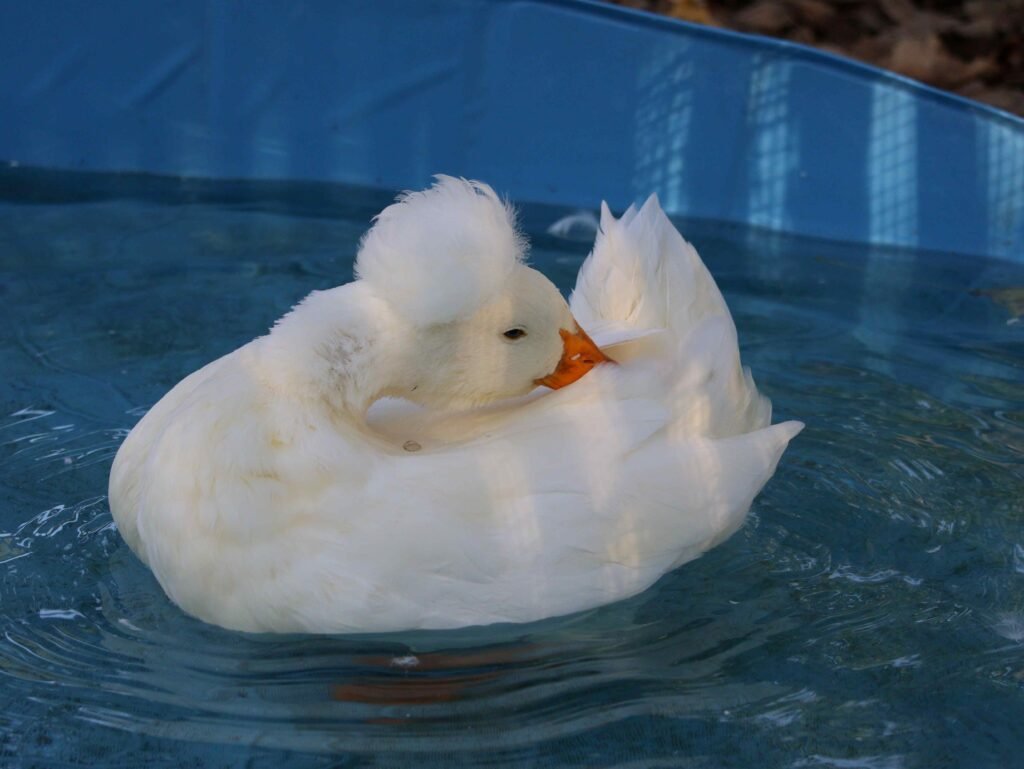
Do a gentle weekly check of each duck’s eyes, nostrils, vent, and feet. Look for signs of swelling, discharge, discoloration, bumblefoot, or signs of a prolapse or injury. While many of these can be treated successfully at home if caught early, they can quickly become serious without intervention.
If you ever notice changes in your duck’s droppings, take photos or collect a sample before heading to the vet. A clear image or a fresh fecal sample can provide your vet with crucial information to guide diagnosis and treatment, especially when dealing with parasites, bacterial imbalances, or internal illness.
And finally—trust your instincts. No one knows your ducks like you do. If something feels off, even if you can’t quite pinpoint what it is, listen to that gut feeling. Ducks rely on our close attention and care, and your intuition, backed by daily observations, is one of the most powerful tools you have.
Relevant Articles
- 16 Common Duck Health Conditions You Should Know About
- 31 Must-have Items for Your Pet Duck First Aid Kit
- How to Conduct a Duck Health Check: A Comprehensive Guide
- Safely Medicating Ducks: A Guide for Pet Duck Owners

